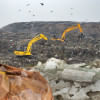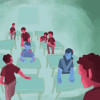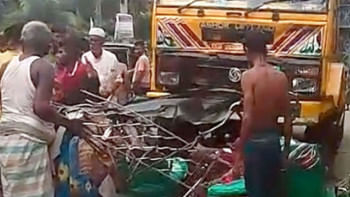The colours and constraints of cosplaying in Bangladesh

Growing up, all I wanted to be in life was Goku. The idea of putting on his blue-orange gi and hitting a kamehameha was something that enamoured me for much of my childhood. But for better or worse, I haven't been able to live up to my dream yet. That is, perhaps, one of the key reasons why I admire and respect cosplayers so much. Despite a barrage of roadblocks, they succeed in materialising the dreams of many.
From protagonists and villains of the same franchise posing for a selfie together to old and new-gen heroes sharing a bite, the air buzzes with excitement and a touch of the surreal at conventions. Such is the allure of cosplaying in Bangladesh. And for a growing number of people, it has become a special way to express creativity and build a community.
While cosplaying has certainly gained traction in recent times, it is by no means an entirely new concept. Shazmeen Haq, popularly known as Sylwen Cosplay in the community, has been a part of this craft since 2014.
"As a fan of anime at the time, I came across some Naruto cosplayers on YouTube, which made me want to dress up as my favourite characters," she recounts. "I tried doing it for fun at first, but later realised I was good at making costumes. That realisation has been the catalyst for pushing me deeper into the craft. Eventually, I became a cosplaying judge and have judged more than fifteen cosplay competitions to date."

Md Rifat Rahman, known to most as 'Orion Cosplay', had a similar cosplaying origin story. His first attempt was at Unmad Jamil's Comic Con in 2015, where his standout feature was nothing more than a Tokyo Ghoul mask.
"I had no idea about the sheer vastness of what cosplaying was," he laughs. "I just knew people dressed up as their favourite characters." Today, Rifat is a serious armour-based cosplayer, spending months perfecting his elaborate designs and bringing ridiculously complex characters to life.
Others, like Maliha Meherin, who goes by the stage name 'Tomie_re', discovered cosplay even earlier. She says, "I first heard about it in 2013 and officially debuted my first cosplay at an event in 2016. At first, it was just a fun hobby, a way to connect with people who loved the same things. But over time, I wanted to take it seriously and do something unique with it."
However, taking this craft seriously does involve steep learning curves. In particular, the process of creating a costume from scratch can take weeks or even months. Rifat, for example, has made the decision to cosplay as only one character every year, investing all his time and effort into producing the best possible outcome.

Explaining his methodical approach, Rifat shares, "First, I gather the raw materials needed for the costume, such as EVA foams, super glue, contact cement, and other accessories. After that, I study my character thoroughly and make a few sketches to understand the patterns of the costume. Then, I start taking measurements of the parts from my body, sketch the patterns, and cut them out from EVA foam. Lastly, I apply priming, paint, sanding, and other additional details required for the final touches."
For Maliha, the focus is on fabric and texture. "I've been making my costumes from scratch since the beginning," she shares. "Through my journey, I've been very picky about fabrics, and I add lace, beads, paint, or even 3D-printed parts to my cosplay when needed. Everything I've picked up has been self-taught through YouTube and Pinterest."
Even for newer faces in the community, the process of making their favourite characters come to life has been driven by passion and a constant urge to improve. Efty Mahbub, a cosplayer who has been in the scene since 2022, has developed his own share of resourceful methods to ensure timely cosplays.
Sharing what he's learnt thus far, he says, "If I want to make something out of EVA foam, my best bet would be to go to Bongshal, where I can buy it in bulk at a cheap rate. If I need any sort of wig, I either go to New Market or, if it's too complicated, order it beforehand on Aliexpress or similar platforms. If I'm working on any fabric-related items, I go to Gausia Market."
He continues, "These skills didn't come naturally, though. I've burned my fingers with hot glue guns and wasted foam on wrong blueprints more times than I can count. But once you fail enough times, you start getting it right, and nothing can beat that satisfaction."
One might wonder, what motivates cosplayers to continue their craft despite the immense hard work that it demands? For Efty, the realm of cosplaying has always felt like a place where he belongs. "Cosplay conventions are places where people don't judge you for being strange," he opines. "Seeing everyone make their own costumes and accessories from scratch was something that I found really inspiring, which, in turn, motivated me to do better as well."
As the craft evolves, so does the community. Depending on who you ask, the cosplay scene in Bangladesh is either blossoming or in transition. "The local scene is still small — maybe consisting of around a hundred people — but everyone knows each other," says Shazmeen. "Watching other talented cosplayers pull off intricate costumes is inspiring. Good or bad, everyone puts in effort."
Yet, those who have been around for a long time see subtle shifts in the culture. "When I started, the community was smaller but full of creativity, making their own costumes all the time," says Maliha. "During and after the pandemic, though, this practice changed a bit. A lot of people started buying their cosplay materials, or even an entire costume, outright. The originality seemed to fade for a while, but I've recently seen the passion coming back."

Not every observation is optimistic, though. Efty, for example, describes the scene as "hanging on a thin string between good and bad". He believes local conventions haven't kept up with international standards like they should have. He also alleges that competitions sometimes tend to reward cosplayers who bought their costumes instead of handmade ones.
"It's discouraging for people who put in every bit of their blood, sweat, and tears behind their dream cosplay," he laments. "Regardless, most cosplayers still work really hard, which keeps the entire community alive."
Recognition, however, remains one of the biggest hurdles for any cosplayer in Bangladesh right now. Despite paying homage to characters as closely as possible, positive outreach remains difficult, which makes it difficult to warrant any sustainable enthusiasm.
"The biggest challenge right now is finding a platform for international exposure," Rifat explains. "Our cosplayers work so hard but rarely get the appreciation they deserve from local audiences or international ones." He points to neighbouring countries, which already have connections to global cosplay networks, as an example; Bangladesh could follow.

The challenges involved are also largely social. "People still don't fully understand cosplay," says Maliha. "We face tons of criticism and harsh comparisons to the original characters. It's frustrating when people dismiss your art because it doesn't match some foreign standard."
Efty agrees, and also raises a more uncomfortable truth — the persistence of bias amongst the local audience. He alleges that people here tend to prefer cosplayers with a lighter complexion. "Brown or darker-skinned cosplayers get harassed online because they don't meet the unrealistic standards set in fiction. That needs to change if we want a healthy, inclusive community," he says.

Then there are the logistical headaches. "Materials are hard to find, traffic eats up your day, and everything's getting expensive," says Shazmeen. "You have to plan months ahead just to pre-order something like a wig. Inflation and limited access to crafting supplies have made cosplay an increasingly demanding pursuit, both financially and mentally."
Despite the obstacles, the passion driving the community remains strong. When asked what the scene needs most, everyone had a similar answer: better conventions, stronger organisation, and more support. Nonetheless, there's a shared optimism among all the cosplay artists I talked to. Although they admit that progress is slow, it is still happening.
Note: We would like to extend our gratitude to the cosplayers Shazmeen Haq, Md Rifat Rahman, and Esfak Mahbub Efty for helping us execute the vision of this photoshoot.
Ayaan immerses himself in dinosaur comics and poorly-written manga. Recommend your least favourite reads at [email protected]

 For all latest news, follow The Daily Star's Google News channel.
For all latest news, follow The Daily Star's Google News channel. 









Comments